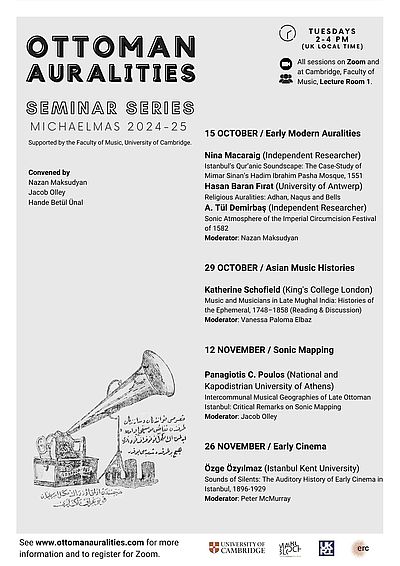(UKRI) OTTOMAN AURALITIES and the Eastern Mediterranean: Sound, Media and Power, 1789-1922
Dynamiques et expériences de la globalisationPrincipal investigator: Peter McMurray (Cambridge)
Senior Researcher: Nazan Maksudyan (CMB)
Funding agency: UK Research and Innovation (UKRI) (replaced ERC grant)
Project partners: University of Cambridge, CMB
Duration: 2022 – 2027
https://ottomanauralities.com/
This project explores histories of sound and audiovisual media in the late Ottoman Empire and eastern Mediterranean (1789-1922), focusing on how sonic practices and their mediations through technical systems produced important new cultural shifts. OTTOMAN AURALITIESseeks to explore the ways in which sound—including music, poetry, sound and other media technologies, urban noise, listening practices, and concepts of sonic experience—played a central role in the cultural history of the late Ottoman Empire and Eastern Mediterranean. This dialogue between sound/media studies with Ottoman history affords an opportunity both to provincialize sound and media studies and to sonify Ottoman history. Additionally, a focus on the Eastern Mediterranean as well as the lives of ethnic minorities, women and other marginalized communities within imperial spaces makes possible a remapping of sonic geographies at the margins of Europe and well beyond. A key component of the project will be an emphasis on sonic cartography, mapping both early audio recordings and textual documents related to sound and media, giving a clearer sense of the cultural and media topographies of this critical period in which telegraphy, audio recording, film, telephony and radio all emerged as important technologies that both shaped and were reconfigured through extant local cultural techniques.
The Project
A core idea of OTTOMAN AURALITIES is the notion of “auralities,” a study of sound, sonic culture and technologies that emerges both in dialogue with and critique of the field of sound studies (Gautier 2014). We also build upon a body of literature on global sonic cultures, either focusing on the aftermath of recording technologies (Denning 2015, Kheshti 2015) or in contemporary settings that employ ethnography as their main methodology (Feld 2012 [1982], Hirschkind 2006, Novak 2013). Two groundbreaking recent volumes of essays, Audible Empire (Radano and Olaniyan 2016) and Remapping Sound Studies (Steingo and Sykes 2019) exemplify these two important trajectories. Yet the historical study of sound and auditory cultures outside Europe and North America remains relatively underdeveloped. Thus in suggesting a “provincializing” of sound studies, to draw on Dipesh Chakrabarty’s classic term for postcolonial historiography (2000), we suggest that an emphasis on the Ottoman Empire and the Eastern Mediterranean, and the techniques and technologies of sounding and listening that were cultivated within those geographies, allows a crucial attempt to rethink notions of sonic modernity that valorize the West.
The study of sound within histories of the Ottoman Empire and the Eastern Mediterranean is beginning to emerge at the intersection of musicology of the Ottoman Empire and cultural history. Histories of recorded music in the Eastern Mediterranean (Ünlü 2016; Abbani 2018, 2022) and musicological works about the early Turkish Republic (O’Connell 2013) add important dimensions to this history as well. The shift from the history of Ottoman art/architecture toward a broader paradigm of visual studies in recent years (e.g., Ersoy 2015, Orkçuoğlu 2020) has inaugurated a wider conceptualization of visuality not rooted in monuments or obvious works of art, per se, but rather in a greater awareness of everyday sensory experience. Nina Ergin has also written key articles on the soundscapes of mosques in Ottoman-era Istanbul (2008) and on women’s sonic experiences of religious architecture (2014). Ziad Fahmy’s new book (2020) on Egyptian auditory culture around the turn of the twentieth century offers an important model for what this kind of sonic history might look like.
KEY THEMES
Given the ubiquity of sound in most all domains of life, we offer thematic areas that will help structure research and allow the project to maintain focus yet think inclusively about whose sonic lives and experiences constituted the Ottoman Empire and Eastern Mediterranean.
1. Circulation: While sound and “soundscape”-oriented projects have often conceived of sound as being connected to a particular location, this project emphasizes from the outset the circulation and mobilities of sound, as well as those people who make or perceive sonic processes.
2. Space and Ecology: Related to the question of circulation is that of space, whether architectural (Ergin, 2008), urban (Fahmy 2020), or rural and/or located in a broader environment (Mikhail 2013). The resonance of various religious buildings, both inside and outside, created defining sensory experiences for many Ottoman subjects and also made cultural difference audible (or intentionally not). Noise, a key dimension of urban sound, will figure prominently in the project, such as in accounts of the packs of wild dogs roaming Istanbul.
3. Voice: Voice studies has emerged as a robust discourse at the intersection of sound studies, psychoanalysis, and the natural sciences (Eidsheim and Meizel 2019). Besides poetry, religious vocal practices play a key role in the project.
4. Infrastructures: Media theorists have increasingly emphasized the centrality of infrastructure (Peters 2015), including both material/inanimate infrastructures (roads, canals, railways) as well as humans involved in labor, maintenance, and societal upkeep. Institutions such as telegraphy stations, railroads, the Ottoman Translation Office (Tercüme Odası), schools (including those for the deaf), early telephone stations, and the Sultan’s court itself all offer important areas for study.
5. Bodies, Gender, Sexuality: Focusing on sound and auditory culture allow new considerations of bodily practice, gender, and the performance of sexuality. Here related subjects of music, performance, and medicine will play a greater role.
6. Techne: This thematic area suggests both material technologies of this period (e.g., telegraphy, photography, gramophone, film, radio) and the “native” techniques people developed to make use of these technologies.
The OTTOMAN AURALITIES-research-team consists of Dr. Peter McMurray, Principal Investigator (University of Cambridge); Prof. Nazan Maksudyan, Senior Researcher (CMB); three Post-Doc researchers: Dr. Vanessa Paloma-Elbaz (University of Cambridge), Dr. Jacob Olley (University of Cambridge) and Dr. Onur Engin (University of Cambridge); two PhD researchers: Hande Betül Ünal (University of Cambridge), Benedict Turner-Berry (University of Cambridge); and affiliated researchers: Dr. Carole Woodall (University of Colorado); Salih Demirtaş (Orient-Institut Istanbul); Dr. Martin Greve (Orient-Institut Istanbul); Dr. Esther Voswinckel (Orient-Institut Istanbul).
In order to secure high standards in research, our Advisory Board consists of Dr. Ziad Fahmy (Cornell University); Dr. Deniz Türker (Rutgers University); Dr. Martin Stokes (King’s College London); Dr. Ahmet Ersoy (Boğaziçi University); and Dr. Nina Ergin (Koç University).
Zeynep Kacmaz Milne (Cambirdge) is the Project Administrator. This transnational research project is made possible with funding from the UK Research and Innovation (UKRI) (EP/X032833/1).

